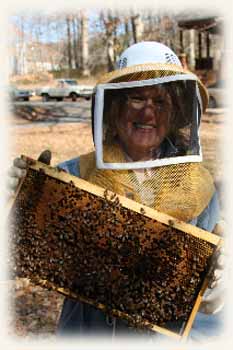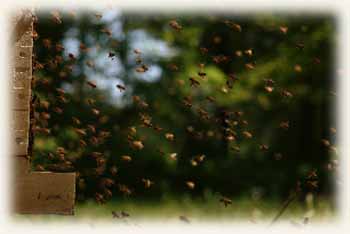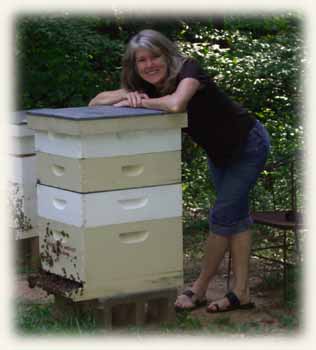The Grapevine Art & Soul Salon
Presentations: Nancy Law
What's in a Name?
Debee DiMenichi is director of I was born to.... workshops, which she has taught throughout the South since 1999. They are designed to help people discover meaning and purpose in their lives and to achieve their “impossible” dreams. She is also a beekeeper, an occupation she came to through a series of serendipitous events.

Debee became interested in the life of Rita, saint of impossible dreams, after watching The Rookie, a movie based on the life of Jim Morris, whose major league pitching dreams were thwarted by an injury. In the film, he moves to Big Lake, Texas, a town built on land consecrated by two nuns scattering rose petals (a symbol of St. Rita) in the hope that oil would be discovered. There, he coaches the losing high school baseball team. It turns out that Big Lake is a place where impossible dreams do come true. Two miracles happen ostensibly as a result of the town's connection to St. Rita—his uninspired high school team starts to win, and Morris gets his chance to pitch in the majors.
Inspired herself, Debee went to the Monastery of the Holy Spirit in Conyers to buy her husband Dante a St. Rita medal-- because she thought he was deserving of one, she says,-- and to read about St. Rita's life (she later returned to the monastery and bought a sterling silver medal for herself, one that she still wears). As a result of her reading about St. Rita, she discovered similarities to her own life in their mutual history of violence and devotion to family.
On the day of St. Rita’s baptism, white bees flew into her nursery and in and out of her mouth, but none stung her. …A legend
On Debee’s way home, two questions kept surfacing in her mind.
What do you love to do? She answered herself, “I love helping people see their dreams come true.”
What does your name mean? Debra is a derivative of the Hebrew Deborah, meaning bee, or “seeking one.”
From the time of that trip, she wondered if honeybees were meant to become a part of her life, and her research began.
Synchronistically, she was invited a short time later to Pacolet, South Carolina, to help rob beehives belonging to a friend’s grandfather. “Robbing” refers to removing the honey from the hives. They extracted 30 gallons of honey from l8 hives.
“Standing under a harvest moon in puddles of honey made me realize the significance of the event and how much I loved it,” Debee said.
About a month later, she returned to Pacolet and bought two hives. A hive is a box or receptacle with movable frames used for housing a colony of bees. She and Dante loaded them into a sixteen-passenger work van, put a screen on the door so the bees couldn’t escape, and returned to Georgia with 100,000 traveling companions. Their son Simon, age 15, helped them unload and place the hives on the bank of the creek near the house.

Early the next morning, fearful that they would be stung, they slowly approached the hives. They removed the screens without incident and began a new life as beekeepers. This happened four years ago. Debee now has four hives that house approximately 200,000 bees.
Debee explained that there are three kinds of bees in a beehive: queens, drones and worker bees. Each has specific duties. The queen bee is the leader. She is the only female with fully developed reproductive organs. The drone's only job is to mate with the queen bee, after which he quickly dies. The female worker bees, whose reproductive organs are not fully developed, do all of the work except lay fertile eggs. Their life span is two or three months. The queen lives a life in darkness except for one excursion out to where drones are waiting. She mates with the strongest drones (which explains the different colors of bees in one hive), returns to the hive and spends the rest of her life laying eggs. The queen retains enough sperm to lay eggs for three to five years, which is her average life span. She can lay as many as 1500 to 2000 eggs per day, 250,000 per year and as many as 1,000,000 in a lifetime.
The honey-making process begins in spring--late March or early April--when vegetables and fruits are flowering. But there is work for the beekeeper before spring arrives. Beginning on Christmas Day, Debee feeds sugar syrup to her bees so they can store up energy. She also leaves them a super (ten frames) of honey to eat in the wintertime. The bees need energy to build wax and for all the new eggs the queen will lay.
There is little activity in the hive during the wintertime. If it gets below 10 degrees, Debee covers the hives with blankets to keep the bees warm. The bees stay together in a tight ball in the center of the hive and, by flapping their wings, they can keep the hive 78 degrees year round.
Debee feeds the bees on a regular basis, but in early spring, she has to watch the hive carefully for signs of overcrowding, which occurs when the bee population outgrows the hive and there is not enough room to lay eggs and store honey. That can result in swarming: the queen and a large group of the worker bees leave the hive to form new colonies to propagate the species. Overcrowding and consequent swarming can be prevented by providing more than enough room for the bees to “rear brood, store honey, nectar, pollen and produce beeswax” (www.beeeducation.com/BeeEducation/Beekeeping 101, Lesson 11).  In addition to providing enough room, she has to make sure the hives are properly ventilated and that there is good air flow and drainage around the hive.
In addition to providing enough room, she has to make sure the hives are properly ventilated and that there is good air flow and drainage around the hive.
Once the flowers are in bloom, the worker bees go back and forth bringing nectar, foraging with their long straw-like tongues, and pollen (protein) that sticks to their bodies as they collect the nectar from the flowers. The bees secrete wax through openings in their abdomens. They shape the wax into perfectly formed cells called honeycomb to hold the honey. The bees make honey by standing over the cells and flapping their wings until the water evaporates from the nectar they’ve brought, and all that is left is honey.
The hives are robbed in late August or early September. Honey day is a day of celebration for Debee and her family. They wear kerchiefs to protect their hair, but their bodies get sticky as they dance around having a good time while working very hard.

The first step in harvesting is bringing the supers full of honey into the house, away from the bees who will attempt to protect their hives. Debee related a story about a man who was extracting the honey in a screened honey house. He couldn’t figure out why it suddenly became so dark. He thought a storm was coming but soon discovered the darkness was caused by the bees covering the screen door while trying to get to their honey.
A full honey super can weigh up to 50 pounds. Each frame in the super has cells of wax full of honey. The frames are kept in a huge Coleman cooler until it is time to extract the honey. Then four frames at a time are put in an extractor. There are different kinds of extractors. Debee’s is like an old fashioned, crank-model ice cream churn. Cheese cloth is placed on top of the extractor to catch any impurities. The initial untapping of the honey occurs when Debee runs a hot electric knife along the top of the comb which allows the honey to flow into a screened five-gallon bucket. As the crank is turned, it spins the frames and the honey is tossed out to the sides of the churn and then flows down into the bucket from which the honey is bottled.
There are many flavors of honey, depending on where the bees go to find the nectar. Two common types are Tupelo and clover. Her bees will travel as far as three miles for nectar. Debee's honey is probably tulip, poplar and blackberry in the spring and goldenrod in the fall. To learn the exact type of honey, a sample has to be analyzed at a lab. Debee has eaten honey from Poland that tasted like Granny Smith apples. I sampled the honey from Debee's bees and it was delicious--robust, smooth and fresh tasting, very sweet. Honey never spoils, she says, because bacteria cannot survive in it.
Honey is a common folk remedy for sore throats, coughs and allergies. Scientists are now studying its infection-fighting properties as well. Debee offers first-hand knowledge of the healing power of honey. Sometimes she has stiffness and swelling in her hands. When this happens, she has Dante get a bee to sting one of the pressure points in her hand. “I can make a fist within three hours, ” she says.
Debee shared an anecdote about the preservative powers of honey taken from a story in Sweetness and Light: The Mysterious History of the Honeybee by Hattie Ellis who recounts that in The Mummy: A Handbook of Egyptian Funerary Archaeology (1964, p. 57), the British Museum's Egyptologist Sir Wallace Budge described a honeyed corpse. A large jar of ancient honey was discovered in a grave by some treasure seekers. One was dipping his bread into the honey for a taste when he noticed a hair: "[A]s they drew it out the body of a small child appeared with all its limbs complete and in a good state of preservation; it was well dressed and had upon it numerous ornaments."
Bees are usually gentle creatures who attack only if they sense a danger, according to Debee.  She explained that when a bee dies, it releases a scent, and other bees come to protect the hive. She says she loves being able to see the bees from her bedroom and kitchen windows and walking out to the hives. Contrary to her original fears, she has been at the hives with only a veil for protection and has never been stung.
She explained that when a bee dies, it releases a scent, and other bees come to protect the hive. She says she loves being able to see the bees from her bedroom and kitchen windows and walking out to the hives. Contrary to her original fears, she has been at the hives with only a veil for protection and has never been stung.
Recent research indicates that bees have facial recognition. Debee believes her bees recognize her. On many occasions she has been comforted by laying her head on top of the hives and listening to the humming of the bees inside. She changed the spelling of her name last year to reflect the presence of the bees in her life. Soon she will be traveling to Rome and then to Cascia in Italy to stay at a monastery and to visit St. Rita's birthplace.
